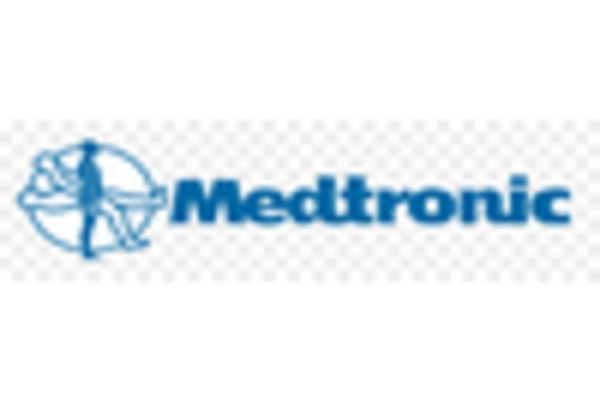-
EXECUTIVE SUMMARY
-
Market Attractiveness
- Global Pediatric Medical Devices Market, by Product
-
Analysis
-
1.1.2.
-
Global Pediatric Medical Devices Market, by End User
-
Global Pediatric
-
Medical Devices Market, by Region
-
MARKET INTRODUCTION
-
Definition
-
Scope of the Study
- Research Objective
- Assumptions
- Limitations
-
RESEARCH METHODOLOGY
-
Overview
-
Data
-
Mining
-
Secondary Research
-
Primary Research
-
Breakdown
-
of Primary Respondents
-
Forecasting Techniques
-
Research Methodology
-
for Market Size Estimation
-
Bottom-Up Approach
-
Top-Down Approach
-
Data Triangulation
-
Validation
-
MARKET DYNAMICS
-
4.1.
-
Overview
-
Drivers
-
Restraints
-
Opportunities
-
5.
-
MARKET FACTOR ANALYSIS
-
Porter’s Five Forces Analysis
- Bargaining Power of Buyers
- Threat of Substitutes
- Intensity of
-
5.1.1.
-
Bargaining Power of Suppliers
-
5.1.3.
-
Threat of New Entrants
-
Rivalry
-
Value Chain Analysis
- R&D and Designing
- Distribution & Sales
- Post Sales Services
-
5.2.2.
-
Manufacturing
-
GLOBAL PEDIATRIC MEDICAL DEVICES MARKET, BY PRODUCT
-
Overview
-
6.2.
-
Cardiology Devices
-
Market Estimates & Forecast, by Region, 2023-2030
-
Market Estimates & Forecast, by Country, 2023-2030
-
In-Vitro Diagnostic
-
(IVD) Devices
-
Market Estimates & Forecast, by Region, 2023-2030
-
Market
-
Estimates & Forecast, by Country, 2023-2030
-
Diagnostic Imaging Devices
-
Market Estimates & Forecast, by Region, 2023-2030
-
Market Estimates &
-
Forecast, by Country, 2023-2030
-
Telemedicine
-
Market Estimates &
-
Forecast, by Region, 2023-2030
-
Market Estimates & Forecast, by Country,
-
Anesthesia and Respiratory Care Devices
-
Market Estimates
-
& Forecast, by Region, 2023-2030
-
Market Estimates & Forecast, by Country,
-
Neonatal ICU Devices
-
Market Estimates & Forecast, by
-
Region, 2023-2030
-
Market Estimates & Forecast, by Country, 2023-2030
-
Monitoring Devices
-
Market Estimates & Forecast, by Region, 2023-2030
-
Market Estimates & Forecast, by Country, 2023-2030
-
Others
-
Market
-
Estimates & Forecast, by Region, 2023-2030
-
Market Estimates & Forecast,
-
by Country, 2023-2030
-
GLOBAL PEDIATRIC MEDICAL DEVICES MARKET, BY END USER
-
Overview
-
Hospitals
-
Market Estimates & Forecast, by Region,
-
Market Estimates & Forecast, by Country, 2023-2030
-
7.3.
-
Pediatric Clinics
-
Market Estimates & Forecast, by Region, 2023-2030
-
Market Estimates & Forecast, by Country, 2023-2030
-
Ambulatory Surgery
-
Centers
-
Market Estimates & Forecast, by Region, 2023-2030
-
Market Estimates
-
& Forecast, by Country, 2023-2030
-
Research and Academic Institutes
-
Market Estimates & Forecast, by Region, 2023-2030
-
Market Estimates &
-
Forecast, by Country, 2023-2030
-
Others
-
Market Estimates & Forecast,
-
by Region, 2023-2030
-
Market Estimates & Forecast, by Country, 2023-2030
-
GLOBAL PEDIATRIC MEDICAL DEVICES MARKET, BY REGION
-
Overview
- North America
-
8.2.
-
Americas
-
8.2.2.
-
Latin America
-
Europe
- Western Europe
- Eastern Europe
-
8.3.1.6.
-
Rest of Western Europe
-
Asia-Pacific
- China
- India
- Australia
- South
- Rest of Asia-Pacific
-
8.4.1.
-
Japan
-
Korea
-
Middle East & Africa
- Africa
-
8.5.1.
-
Middle East
-
COMPANY LANDSCAPE
-
Overview
-
9.2.
-
Competitor Dashboard
-
Major Growth Strategies in the Pediatric Medical
-
Devices Market
-
Competitive Benchmarking
-
The Leading Players
-
in terms of Number of Developments in the Pediatric Medical Devices Market
-
9.6.
-
Key Developments & Growth Strategies
-
Major Market Players Financial
-
Matrix & Market Ratio
-
COMPANY PROFILES
-
Abbott Laboratories
- Company Overview
- Products/Services Offered
- Key Developments
- SWOT Analysis
-
(US)
-
10.1.3.
-
Financial Overview
-
10.1.6.
-
Key Strategies
-
Boston Scientific Corporation (US)
- Company
- Products/Services Offered
- Financial Overview
- Key Developments
- SWOT Analysis
- Key Strategies
-
Overview
-
Medtronic PLC (Ireland)
- Company Overview
- Products/Services
- Financial Overview
- Key Developments
- Key Strategies
-
Offered
-
10.3.5.
-
SWOT Analysis
-
Cardinal Health (US)
- Products/Services Offered
- Financial Overview
- Key Developments
- SWOT Analysis
- Key Strategies
-
10.4.1.
-
Company Overview
-
F. Hoffmann-La Roche Ltd (Switzerland)
- Company Overview
- Products/Services Offered
- Financial Overview
- SWOT Analysis
- Key Strategies
- Company Overview
- Products/Services
- Financial Overview
- Key Developments
- Key Strategies
-
10.5.4.
-
Key Developments
-
10.6.
-
GE Healthcare (US)
-
Offered
-
10.6.5.
-
SWOT Analysis
-
Philips Healthcare (US)
- Company Overview
- Products/Services Offered
- Financial
- Key Developments
- SWOT Analysis
- Key
-
Overview
-
Strategies
-
Baxter (US)
- Company Overview
- Products/Services
- Financial Overview
- Key Developments
- Key Strategies
-
Offered
-
10.8.5.
-
SWOT Analysis
-
Siemens Healthineers (Germany)
- Company Overview
- Products/Services Offered
- Financial
- Key Developments
- SWOT Analysis
- Key
-
Overview
-
Strategies
-
Stryker Corporation (US)
- Company Overview
- Products/Services Offered
- Financial Overview
- SWOT Analysis
- Key Strategies
-
10.10.4.
-
Key Developments
-
11.
-
APPENDIX
-
References
-
Related Reports
-
-
LIST
-
OF TABLES
-
GLOBAL PEDIATRIC MEDICAL DEVICES MARKET SYNOPSIS, 2023-2030
-
GLOBAL PEDIATRIC MEDICAL DEVICES MARKET ESTIMATES & FORECAST, 2023-2030
-
(USD MILLION)
-
GLOBAL PEDIATRIC MEDICAL DEVICES MARKET, BY PRODUCT,
-
GLOBAL PEDIATRIC MEDICAL DEVICES MARKET, BY
-
END USER, 2023-2030 (USD MILLION)
-
GLOBAL PEDIATRIC MEDICAL DEVICES
-
MARKET, BY REGION, 2023-2030 (USD MILLION)
-
NORTH AMERICA: PEDIATRIC
-
MEDICAL DEVICES MARKET, BY PRODUCT, 2023-2030 (USD MILLION)
-
NORTH AMERICA:
-
PEDIATRIC MEDICAL DEVICES MARKET, BY END USER, 2023-2030 (USD MILLION)
-
TABLE
-
US: PEDIATRIC MEDICAL DEVICES MARKET, BY PRODUCT, 2023-2030 (USD MILLION)
-
TABLE
-
US: PEDIATRIC MEDICAL DEVICES MARKET, BY END USER, 2023-2030 (USD MILLION)
-
CANADA: PEDIATRIC MEDICAL DEVICES MARKET, BY PRODUCT, 2023-2030 (USD
-
MILLION)
-
CANADA: PEDIATRIC MEDICAL DEVICES MARKET, BY END USER, 2023-2030
-
(USD MILLION)
-
LATIN AMERICA: PEDIATRIC MEDICAL DEVICES MARKET, BY
-
PRODUCT, 2023-2030 (USD MILLION)
-
LATIN AMERICA: PEDIATRIC MEDICAL
-
DEVICES MARKET, BY END USER, 2023-2030 (USD MILLION)
-
EUROPE: PEDIATRIC
-
MEDICAL DEVICES MARKET, BY PRODUCT, 2023-2030 (USD MILLION)
-
EUROPE:
-
PEDIATRIC MEDICAL DEVICES MARKET, BY END USER, 2023-2030 (USD MILLION)
-
TABLE
-
WESTERN EUROPE: PEDIATRIC MEDICAL DEVICES MARKET, BY PRODUCT, 2023-2030 (USD
-
MILLION)
-
WESTERN EUROPE: PEDIATRIC MEDICAL DEVICES MARKET, BY END
-
USER, 2023-2030 (USD MILLION)
-
EASTERN EUROPE: PEDIATRIC MEDICAL DEVICES
-
MARKET, BY PRODUCT, 2023-2030 (USD MILLION)
-
EASTERN EUROPE: PEDIATRIC
-
MEDICAL DEVICES MARKET, BY END USER, 2023-2030 (USD MILLION)
-
ASIA-PACIFIC:
-
PEDIATRIC MEDICAL DEVICES MARKET, BY PRODUCT, 2023-2030 (USD MILLION)
-
TABLE
-
ASIA-PACIFIC: PEDIATRIC MEDICAL DEVICES MARKET, BY END USER, 2023-2030 (USD MILLION)
-
MIDDLE EAST & AFRICA: PEDIATRIC MEDICAL DEVICES MARKET, BY PRODUCT,
-
MIDDLE EAST & AFRICA: PEDIATRIC MEDICAL
-
DEVICES MARKET, BY END USER, 2023-2030 (USD MILLION)
-
-
LIST OF FIGURES
-
RESEARCH PROCESS
-
MARKET STRUCTURE OF THE GLOBAL PEDIATRIC
-
MEDICAL DEVICES MARKET
-
MARKET DYNAMICS OF THE GLOBAL PEDIATRIC MEDICAL
-
DEVICES MARKET
-
GLOBAL PEDIATRIC MEDICAL DEVICES MARKET SHARE, BY PRODUCT,
-
GLOBAL PEDIATRIC MEDICAL DEVICES MARKET SHARE, BY END USER,
-
GLOBAL PEDIATRIC MEDICAL DEVICES MARKET SHARE, BY REGION,
-
AMERICAS: PEDIATRIC MEDICAL DEVICES MARKET SHARE BY REGION,
-
NORTH AMERICA: PEDIATRIC MEDICAL DEVICES MARKET SHARE, BY
-
COUNTRY, 2020 (%)
-
EUROPE: PEDIATRIC MEDICAL DEVICES MARKET SHARE,
-
BY REGION, 2020 (%)
-
WESTERN EUROPE: PEDIATRIC MEDICAL DEVICES MARKET
-
SHARE, BY COUNTRY, 2020 (%)
-
ASIA-PACIFIC: PEDIATRIC MEDICAL DEVICES
-
MARKET SHARE, BY COUNTRY, 2020 (%)
-
MIDDLE EAST & AFRICA: PEDIATRIC
-
MEDICAL DEVICES MARKET SHARE, BY COUNTRY, 2020 (%)
-
GLOBAL PEDIATRIC
-
MEDICAL DEVICES MARKET: COMPANY SHARE ANALYSIS, 2020 (%)
-
ABBOTT LABORATORIES:
-
KEY FINANCIALS
-
ABBOTT LABORATORIES: SEGMENTAL REVENUE
-
FIGURE
-
ABBOTT LABORATORIES: REGIONAL REVENUE
-
BOSTON SCIENTIFIC CORPORATION:
-
KEY FINANCIALS
-
BOSTON SCIENTIFIC CORPORATION: SEGMENTAL REVENUE
-
BOSTON SCIENTIFIC CORPORATION: REGIONAL REVENUE
-
MEDTRONIC
-
PLC: KEY FINANCIALS
-
MEDTRONIC PLC: SEGMENTAL REVENUE
-
FIGURE
-
MEDTRONIC PLC: REGIONAL REVENUE
-
CARDINAL HEALTH: KEY FINANCIALS
-
CARDINAL HEALTH: SEGMENTAL REVENUE
-
CARDINAL HEALTH: REGIONAL
-
REVENUE
-
F. HOFFMANN-LA ROCHE LTD: KEY FINANCIALS
-
F.
-
HOFFMANN-LA ROCHE LTD: SEGMENTAL REVENUE
-
F. HOFFMANN-LA ROCHE LTD:
-
REGIONAL REVENUE
-
GE HEALTHCARE: KEY FINANCIALS
-
GE
-
HEALTHCARE: SEGMENTAL REVENUE
-
GE HEALTHCARE: REGIONAL REVENUE
-
PHILIPS HEALTHCARE: KEY FINANCIALS
-
PHILIPS HEALTHCARE:
-
SEGMENTAL REVENUE
-
PHILIPS HEALTHCARE: REGIONAL REVENUE
-
FIGURE
-
BAXTER: KEY FINANCIALS
-
BAXTER: SEGMENTAL REVENUE
-
FIGURE 37
-
BAXTER: REGIONAL REVENUE
-
SIEMENS HEALTHINEERS: KEY FINANCIALS
-
SIEMENS HEALTHINEERS: SEGMENTAL REVENUE
-
SIEMENS HEALTHINEERS:
-
REGIONAL REVENUE
-
STRYKER CORPORATION: KEY FINANCIALS
-
FIGURE
-
STRYKER CORPORATION: SEGMENTAL REVENUE
-
STRYKER CORPORATION: REGIONAL
-
REVENUE










Leave a Comment